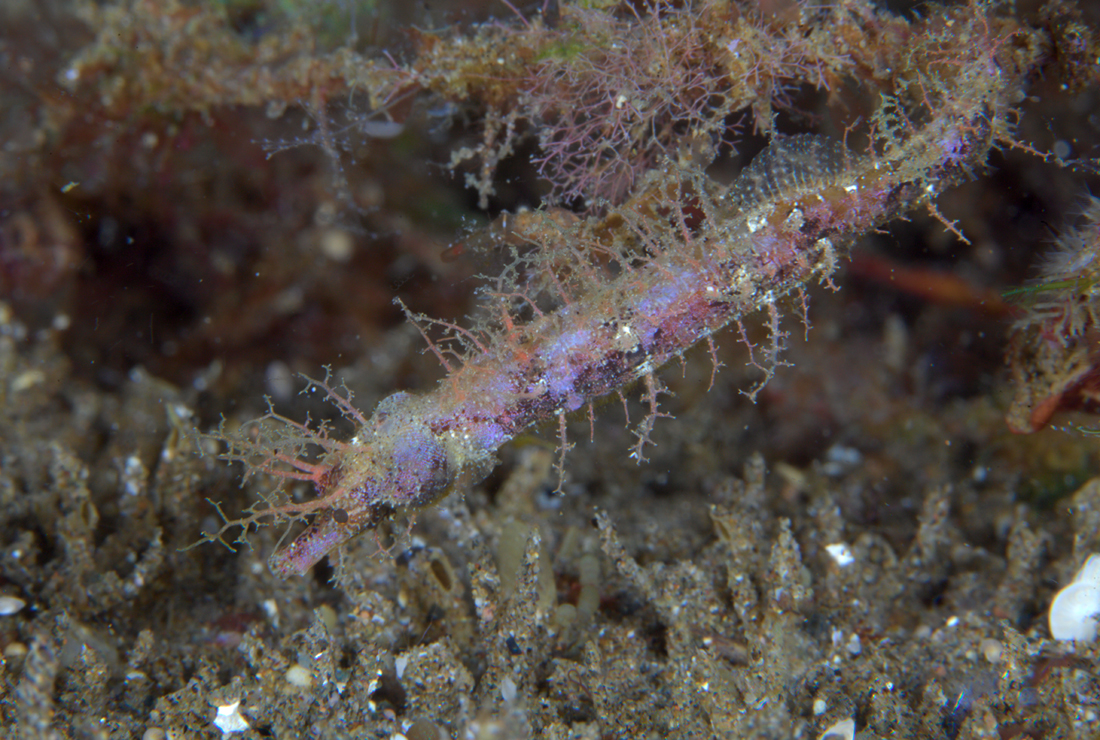Tasselled Pipefish, Halicampus brocki (Herald 1953)

A Tasselled Pipefish, Halicampus brocki, at Dauin, Philippines. Source: Klaus Stiefel / Flickr. License: CC By Attribution-NonCommercial
A whitish to yellowish pipefish with short skin flaps on the body and longer branched filaments in the head. Some individuals are brown with pale saddles along the back. This slender, reef-dwelling pipefish is solitary and secretive.
Tasselled Pipefish, Halicampus brocki (Herald 1953)
More Info
|
Distribution |
Recorded in Australia from scattered locations in north Western Australia, the Northern Territory and Queensland. Found elsewhere in the tropical Western Pacific - from the Philippines and north to the Ryukyu Islands, Japan, south to northern Australia, the Coral Sea, eastwards to Micronesia. Usually inhabits patches of coral and macro-algae on coastal reefs at 3-45 m. |
|
Features |
Meristic features: Dorsal fin 21-23; Anal fin usually 4; Pectoral fin 11-14; Trunk rings 14; Tail rings 33-37. Body slender; median dorsal snout ridge discontinuous with three semi-isolated crests in subadults-adults with denticulate to spiny margins; 1-2 lateral spines on the snout; dorsal rim of orbit elevated, often with spines or serrations; principle body ridges elevated; superior ridges of trunk rings with 3-5 strong spine-like serrations; head with filamentous tentacles; back often with dermal flaps. Pectoral fin base with one distinct ridge, base protruding laterally, more so in juveniles than in adults. |
|
Size |
To 11.5 cm TL |
|
Colour |
Whitish, yellowish or pale brown to tan, often with three brown bars on the snout and suborbital region, and 10-11 diffuse pale bars or saddles on the body. |
|
Feeding |
Likely to feed on small crustaceans. |
|
Biology |
Males brood the eggs in a semi-exposed pouch under the trunk. Males may begin brooding at 90mm TL. |
|
Fisheries |
Sometimes collected for the aquarium trade. |
|
Conservation |
Marine listed under the Environment Protection and Biodiversity Conservation Act 1999. |
|
Remarks |
With its branching tentacles, H. brocki is well camouflaged amongst algal growth. |
|
Similar Species |
H. dunckeri and H. brocki attain a similar size and both may have filaments on the head, but these are branched in H. brocki and simple in H. dunckeri. H. brocki also has a greater number of tail rings (33-37 versus 31-36), dorsal fin rays (21-23 versus 16-20) and pectoral fin rays (11-14 versus 10-13). |
|
Etymology |
Halicampus is from the Greek, als, alis for salt and the Greek, kampe meaning bend. |
|
Species Citation |
Micrognathus brocki Herald 1953, Bull. US Nat. Mus. 202(1): 263, Figs. 39g, 40. Type locality: lagoon in Amen Island, Bikini Atoll, Marshall Islands, depth 30 feet. |
|
Author |
Thompson, Vanessa J. & Dianne J. Bray |
Tasselled Pipefish, Halicampus brocki (Herald 1953)
References
Allen, G.R. 1997. Marine fishes of tropical Australia and south-east Asia. Western Australian Museum, Perth. 292 pp.
Allen, G.R. & M. Adrim. 2003. Coral reef fishes of Indonesia. Zool. Stud. 42(1): 1-72.
Allen, G.R. & R. Swainston. 1988. The marine fishes of north-western Australia. A field guide for anglers and divers. Western Australian Museum, Perth. 201 pp.
Dawson, C.E. 1985. Indo-Pacific Pipefishes (Red Sea to the Americas). Gulf Coast Research Laboratory, Ocean Springs, Mississippi. 230 pp.
Fricke, R. 2004. Review of the pipefishes and seahorses (Teleostei: Syngnathidae) of New Caledonia, with descriptions of five new species. Stuttgarter Beiträge zur Naturkunde. Serie A (Biologie). 66S: 1-66.
Herald, E.S. 1953. Family Syngnathidae: pipefishes, pp 231-278 In Schultz, L.P., E.S. Herald, E.A. Lachner, A.D. Welander & L.P. Woods (eds.) Fishes of the Marshall and Marianas Islands. Vol. 1. Families Asymmetronidae through Siganidae. Bull. U.S. Natl. Mus. 202(1): 1-685.
Hoese, D.F., D.J. Bray, J.R. Paxton & G.R. Allen. 2006. Fishes. In Beesley, P.L. & A. Wells (eds). Zoological catalogue of Australia. Volume 35. ABRS & CSIRO Publishing: Australia. 2178 pp.
Kuiter, R.H. 2000. Seahorses, Pipefishes and their Relatives. TMC Publishing, Chorleywood, UK. 240 pp.
Kuiter, R.H. & T. Tonozuka. 2001. Pictorial guide to Indonesian reef fishes. Part 1. Eels- Snappers, Muraenidae - Lutjanidae. Zoonetics, Australia. 302 pp.
Michael, S.W. 1998. Reef Fishes Volume 1. A Guide to Their Identification, Behaviour and Captive Care. Microcosm Ltd. Shellbourne, Vermont. 624 pp.
Myers, R.F. 1999. Micronesian reef fishes. A comprehensive guide to the coral reef fishes of Micronesia. 3rd revised ed. Coral Graphics, Guam. 330 pp, 192 pls.
Nakabo, T. 2002. (Ed.) Fishes of Japan with pictorial keys to the species. English edition. Tokai University Press. vol. 1, 866 pp.
Pogonoski, J.J., D.A. Pollard & J.R. Paxton. 2002. Conservation Overview and Action Plan for Australian Threatened and Potentially Threatened Marine and Estuarine Fishes, Environment Australia, Canberra. 375 pp.
Paulus, T. 1999. Family Syngnathidae. pp 2264-2276, In Capenter K.E. & Niem V.H. (eds) The Living Marine Resources of the Western Central Pacific. FAO Species Identification Guide For Fisheries Purposes. FAO Vol. 4. pp 2069-2790.
Randall, J.E., Allen, G.R. & R.C. Steene. 1997. Fishes of the Great Barrier Reef and Coral Sea. Crawford House Press. Bathurst. 557 pp.
Senou, H. & M. Aizawa. 1993. Two rare species of the genus Halicampus (Pisces; Syngnathidae) from the Ryukyu Islands. I. O. P. Diving News 4(1)]: 4-5. [In Japanese, English abstract.]




